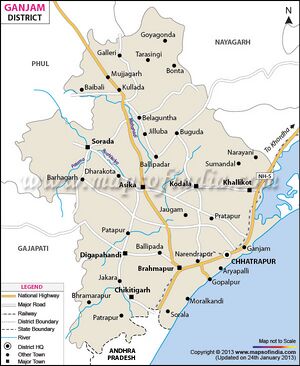Kimidi
| Author:Laxman Burdak, IFS (R) |

Kimidi is a Kingdom mentioned as Khimidi in Ratanpur Stone Inscription Of Jajalladeva I - (Kalachuri) Year 866 (=1114 AD). Khimidi is probably identical with the Zamindari named Kimidi in the Ganjam District. It is mentioned with Kosala (modem Chhattisgarh) in the Dïrghâsi (दीर्घासि) stone inscription. (p.411)[1][2]
Variants
- Khimidi (खिमिडी)
- Khimmindi (खिम्मिण्डि) (Koni Stone Inscription Of Prithvideva II - (Kalachuri) Year 900 (=1148 AD), Verse 26)
Jat Gotras Namesake
- Khimivia (Jat clan) = Khimidi mentioned in V.23 of Ratanpur Stone Inscription Of Jajalladeva I - (Kalachuri) Year 866 (=1114 AD).[3]
- Khimivia (Jat clan) = Khimmindi (खिम्मिण्डि) mentioned Koni Stone Inscription Of Prithvideva II - (Kalachuri) Year 900 (=1148 AD) Verse 26.[4]
- Kim (Jat clan) = Kimidi in Ganjam district of Orissa. Khimidi mentioned in V.23 of Ratanpur Stone Inscription Of Jajalladeva I - (Kalachuri) Year 866 (=1114 AD).[5]
History
Kalachuri King Jajalladeva (I)'s friendship was sought by the lord of Chedi. He was also honoured with presents of wealth by the kings of Kanyakubja (कान्यकुब्ज) and Jejabhukti (जेजाभुक्ति). He defeated Sômësvara (सोमेश्वर) and imprisoned him together with his ministers and wives, but afterwards released them as desired by his mother. The kings of Kosala (कोसल), Andhra (आंध्र), Khimidi (खिमिडी), Vairagara (वैरागर), Lanjika (लान्जिका), Bhanara (भाणार), Talahari (तलहारी), Dandakapura (दण्डकपुर), Nandavali (नन्दावली) and Kukkuta (कुक्कुट) paid annual tributes or presents to him. (p.410)[6]
Ratanpur Stone Inscription Of Jajalladeva I - (Kalachuri) Year 866 (=1114 AD) mentions ....(V.23) To whom the princely rulers of these mandalas, viz , [Dakshi]na-Kôsala (कोसल), Andhra (आंध्र), Khimidî (खिमिडी), Vairâgara (वैरागर), Lanjikâ (लान्जिका), Bhânâra (भाणार), Talahâri (तलहारी), Dandakapura (दण्डकपुर), Nandavali (नन्दावली) (and) Kukkuta (कुक्कुट) — some out of friendship, some in order to please, gave him (Jajalladeva) .... fixed year after year.(p.416)[7]
Koni Stone Inscription Of Prithvideva II - (Kalachuri) Year 900 (=1148 AD)
Koni Stone Inscription Of Prithvideva II - (Kalachuri) Year 900 (=1148 AD) mentions in Verse 26 about the exploits of Purushôttama. He conquered the Khimmindi mandala, made the Talahâri mandala attractive, punished Dandapura, subjugated Khijjinga, killed Haravôhu and threatened the ruler of Dandabhukti. It may be noted that some of these countries are also mentioned in a fragmentary verse eulogising the Kalachuri king Jajalladeva I, which occurs in his Ratanpur stone inscription, dated K 8663 Jajalladeva is said to have received annual tributes from the rulers of Dakshina Kosala, Andhra, Khimidi, Vairagara, Lanjikâ, Bhanara, Talahari, Dandakapura, Nandavali and Kukkuta. It will be noticed that Khimidi, Talahari and Dandapura (दण्डपुर) are common to the two lists of countries. It may therefore be conjectured that Purushôttama took a prominent part in the expeditions of Jajalladeva I against the rulers of these three countries. (p.465). [8]
The present inscription no doubt states that Purushôttama was made Sarvâdhikàrin by Ratnadëva II but that does not necessarily imply that he first came into prominence during that king's reign. He may have held the office of a minister under Jajalladeva I also, and may have distinguished himself during that king's wars. Of these three countries, Talahari mandala was probably the name of the southern portion of the Bilaspur tahsil and the adjoining portion of the Jânjgir tahsil. Jajalladeva's conquest of Talahari is mentioned in some other records of the period4 Khimmindi or Khimidi may be the former Kimedi Zamindari in the Ganjam District. Jajalladeva I's expedition against this country, which probably owned the suzerainty of the Eastern Gangas, may have provoked Anantavarman-Chôdaganga into launching his invasion of the Kalachuri kingdom during the reign of Jâjalladeva's son and successor Ratnadeva II. Nothing is known about the expedition against Dandapura. This town may have been the capital of Dandabhukti. (p.465) . [9]
External links
References
- ↑ Ep Ind, VOL IV, pp 314-18
- ↑ Corpus Inscriptionium Indicarium Vol IV Part 2 Inscriptions of the Kalachuri-Chedi Era, Vasudev Vishnu Mirashi, 1955, p.409-417
- ↑ Corpus Inscriptionium Indicarium Vol IV Part 2 Inscriptions of the Kalachuri-Chedi Era, Vasudev Vishnu Mirashi, 1955, p.409-417
- ↑ Corpus Inscriptionium Indicarium Vol IV Part 2 Inscriptions of the Kalachuri-Chedi Era, Vasudev Vishnu Mirashi, 1955, p. 463-473
- ↑ Corpus Inscriptionium Indicarium Vol IV Part 2 Inscriptions of the Kalachuri-Chedi Era, Vasudev Vishnu Mirashi, 1955, p.409-417
- ↑ Corpus Inscriptionium Indicarium Vol IV Part 2 Inscriptions of the Kalachuri-Chedi Era, Vasudev Vishnu Mirashi, 1955, p.409-417
- ↑ Corpus Inscriptionium Indicarium Vol IV Part 2 Inscriptions of the Kalachuri-Chedi Era, Vasudev Vishnu Mirashi, 1955, p.409-417
- ↑ Corpus Inscriptionium Indicarium Vol IV Part 2 Inscriptions of the Kalachuri-Chedi Era, Vasudev Vishnu Mirashi, 1955, p. 463-473
- ↑ Corpus Inscriptionium Indicarium Vol IV Part 2 Inscriptions of the Kalachuri-Chedi Era, Vasudev Vishnu Mirashi, 1955, p. 463-473
Back to Orissa

